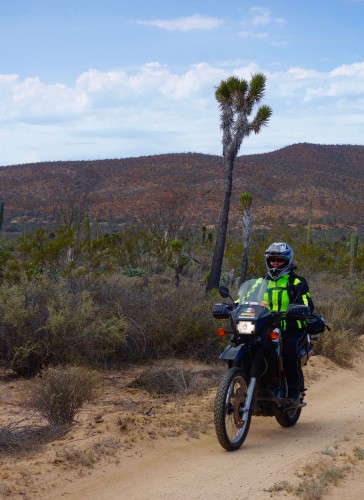
Alone off-road in Baja.
By Carla King
Whether you’re staying on the well-traveled routes or wandering off onto the dirt tracks to fishing camps, missions, and oasis, here’s what you need to know about trip, vehicle, and evacuation insurance, how it really works, gear, and costs. This post is for anybody on two or four wheels, boating, hiking, diving or flying in Baja.
But first, an observation. Mostly, I’ve seen people get hurt when they’re following friends where they shouldn’t, like the three guys I wrote about in an earlier post, one of whom had the wrong kind of bike for dirt track but followed his friends on big dual-sport bikes, anyway. He would have been smarter to meet them on the highway further south where the trail meets the road. He barely managed to limp out with broken bones and a broken bike. His trip was over.
Accidents can happen anywhere, but that doesn’t mean they’re common. Baja is generally safe, with friendly people, spectacular nature, and considerable opportunity for exploration. Local ranchers travel the byways in battered trucks, on foot, or donkey and, lacking telephone or cell service, nearly every ranch has a radio.
Read on for information about personal satellite messengers, emergency medical, travel insurance, search and rescue, and getting back home.
Here are some quick links to the content in this long post.
- Celia Diaz’s Binational Emergency Service
- Just dial 911
- Ranchers, fishermen, and radios
- About those emergency vehicles…
Search & rescue evacuation insurance choices
Motorcycle (and vehicle) insurance
Got recommendations? A story to tell?
Before You Start
This is a long article with lots of comparisons, so you’re going to want to take notes and click the links. Also, check your credit cards for travel insurance perks like trip cancelation so you don’t pay for services you don’t need. Also, leave a contact list with family or friends for the companies you choose, so they can help if needed.
Here we go!
Satellite Messengers
I own an old SPOT satellite messenger which I’ve used as an emergency device (never had to push that SOS button) and a tracker so that readers could follow my trips on my website. I was considering an upgrade to the latest model until I read a friend’s blog post on his backcountry rescue experiences. (However, I’m still tempted to nab the SPOT Trace theft-alert tracking device.)

Image courtesy Pete Day, Mosko Moto
Pete Day, founder of Mosko Moto (who makes the soft luggage I carry on my KTM dual-sport) is a crazy adventurous traveler. A couple of years ago he was riding alone deep in the jungle in Honduras and severely broke his ankle. The SPOT has no two-way communication (still doesn’t) so he had to hit the SOS button and trust that help was on its way. But he didn’t trust, because he knew that the Honduras authorities were only reliably motivated by bribery. (Thankfully not true for Baja.) As he waited, he wished for a two-way device so that he could text his parents the location of the Peace Corps guy he met in the last town who would have been able to negotiate a rescue. That evening, an Army patrol making their weekly pass through got him out. He was lucky!
When Pete got home he did a lot of research and bought the Garmin InReach, and carries it everywhere from Africa to Indonesia to the American backcountry. When he and his friend Ashley were motorcycling in Eastern Oregon, Ashley squeezed her ankle between the motor and a rock, breaking some bones and losing some bike parts.
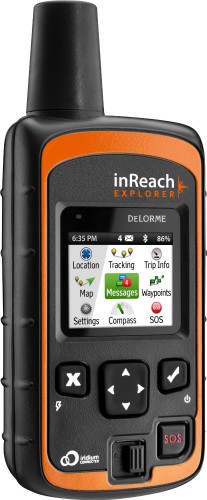 Pete pushed the SOS button and got a message back that help was on its way. The BLM Rangers and Search & Rescue personnel who responded were also carrying the InReach, which they highly recommended. You can use the device to text, or pair it with your mobile to communicate with family and friends, and to access topo maps and NOAA charts. Other features include a digital compass, built-in navigation, and an Automatic Flight Following/Ping-Me Locating feature for pilots.
Pete pushed the SOS button and got a message back that help was on its way. The BLM Rangers and Search & Rescue personnel who responded were also carrying the InReach, which they highly recommended. You can use the device to text, or pair it with your mobile to communicate with family and friends, and to access topo maps and NOAA charts. Other features include a digital compass, built-in navigation, and an Automatic Flight Following/Ping-Me Locating feature for pilots.
Clip it on your person and not to your vehicle, just in case you get separated. It’s been known to happen!
You can purchase the InReach Explorer $459.99 wearable with power pack and TOPO maps or the InReach Mini ($343.59) on Amazon.
Here’s more reading on satellite messengers and personal locator beacons.
- Pete’s story on the backcountry search and rescue response with the InReach (Mosko Moto)
- A search and rescue exercise (Adventure Rider)
- What happens when you press the SOS button (Expedition Portal)
- Review of locator beacons and satellite messengers (Expedition Portal)
Search and Rescue
I didn’t realize until recently that evacuation service insurance only covers transport from facility to facility. So whether you’re motorcycling in the desert, hiking a canyon, or on a boat in the Sea of Cortez, you’re going to need to fill this gap. This is the motivation behind Celia Diaz’s Binational Emergency service.
Celia Diaz’s Binational Emergency Service
 Sign up: http://binationalemergency.org
Sign up: http://binationalemergency.org
1-619-425-5080
Binational Emergency is a nonprofit organization with local knowledge and relationships with people who can help. Their $45 annual fee is well worth it, over and above your medical and emergency evacuation service (Discover Baja members get discounted rates on Binational membership). Because if you can’t get the word out, you’re just stuck in the woods, so to speak.
Binational has contacts on both sides of the border with experts in the medical field, federal, state and local law enforcement agencies, social workers, consular officials and hospital personnel. They have contacts with local pilots, ranchers and boaters. Some of these people and organizations will need reimbursement for charges from efforts made on your behalf. However, if you do not have insurance or the money to pay for the evacuation, Binational will look for a volunteer pilot, which can take some time.
I know that pilots in Mulegé parked at Serenidad airstrip have done their share of search and rescue. They don’t charge for their but do appreciate being reimbursed for fuel. If your emergency is extreme, Binational will enlist the US coast guard but they are not always able to respond.
Which is what makes Binational a fantastic addition to your travel and evacuation insurance. So do join this great nonprofit service before your trip. Give Binational’s information to your friends, family, and people you meet on the road so that they can easily locate you and get help.
A couple of years ago some kayakers did not make their destination in the often unpredictable waters of the Sea of Cortez, causing their family to spring into action. A neighbor with a plane at Serenidad airstrip volunteered to sweep Bahía Concepción and the Mexican Navy went out to look, too. With sadness, everyone abandoned hope, but it turned out that the kayakers had just changed their plan and were enjoying some time at a remote island. Please don’t be those people.
Contact your country’s embassy or consulate in Baja
The U.S. Embassy & Consulates in Mexico website states that “a consular officer can assist in locating appropriate medical services and informing family or friends. If necessary, a consular officer can also assist in the transfer of funds from the United States. However, payment of hospital and other expenses is the responsibility of the traveler.” [Emphasis theirs.]
The US embassy site maintains a list of hospitals in Mexico. You’ll find the Baja list here under “Medical Practitioners.”
The Consular Agency of Canada has locations in Tijuana and San Jose del Cabo.
Dial 911
You can dial 911 to reach Baja’s emergency services but don’t count on getting a signal. I have TMobile’s 3 Country plan but cell coverage is spotty or nonexistent in most of the areas where it’s really fun to ride, hike and explore the missions, canyons, and nature. You won’t find a signal in Cataviña, Bahía de Los Ángeles, or in the beautiful terrain inland outside of Mulegé, Loreto, and San Juanico.
If you do get a signal, just dial 911. Mexico as a country adopted 911 as their emergency services phone number in 2017. I’ve been told that you don’t need to punch in the country code, even if you’re using a foreign phone.

Help on the hoof!
Ranchers, fishermen, and radios
If you don’t use a satellite tracker, or even if you do, one of your traveling companions may go for help. Or you may enlist a local rancher on horseback—more common than you might think—to radio in your location. In the absence of cell service, the rancheros communicate by radio and can notify local emergency services like an ambulance or the bomberos (fire department). You may need to ride in a truck bed to an access point: road, airstrip, or boat. Some of the more permanent fish camps may have radios, or they may motor out to a yacht if they’ve seen one and have the gas to spare. (Offer to pay them.) Again, Binational’s bilingual staff are a great help as they’re available 24/7. Even so, things will probably happen slowly, so try to relax.
About those emergency vehicles…
The emergency vehicle nearest our place is parked on empty due to lack of funds. They don’t fill up the tank because somebody might “borrow” the gas for their own vehicle. So before they can respond the driver will need money for gas and time to go to the gas station. And they may not be as prepared as you expect them to be. No to mention that nothing happens as quickly as it does in America del Norte.
For example, when a neighbor needed medical transport to La Paz the ambulance was not equipped with the oxygen necessary for the trip. To help, a friend—a local fisherman and diver—drove to Loreto to get his dive tank filled. (There’s no compressor in Mulegé since the dive shop closed two years ago.) Four hours later he returned and rode along in the ambulance (back past Loreto), to Hospital Generalaria Juan María de Salva Tierra in La Paz (considered the best in the state). Then the hospital required 10,000 pesos ($500) before they would admit her. He would not normally have had that much cash in his pocket, but in a crazy coincidence, that morning I had paid him exactly 10,000 pesos to fix our boat. I wish this story had a happy ending. But our neighbor had led a long and happy life and her family was able to join her in time to say goodbye.
Read this report by adventure motorcyclist Christopher Baker on his evac experience after breaking a leg trying to keep up with a fast-paced buddy on a sandy trail. Strangely, the story may make you feel better.
NOTE: If you’re in a tourist area like Cabo San Lucas you may be diverted to a “Doc in a Box” facility with predatory pricing. Here’s a thoughtful article on how to avoid these gougers and other great information about emergency care in Baja.
Getting care
Do pack a first aid kit, but not one of those miniature survival kits, please! (Link is to an amusing kit review on Exploring Overland.) Start with a high-quality and customize it to make it your own. Here’s an ultralight done-it-for-you kit, which is a good start, but it’s best to build your own kit. See this comprehensive survival kit list on Hunting Mark with lots of how-to videos. In the ADV Rider article, the recommendation to replace your roadside repair mat with a lightweight panel signal so evac personnel can find you is a good one.
Try to steer your rescuers to a hospital that serves a lot of gringos, such as La Paz or Los Cabos or, if you’re up north, Ensenada, Tijuana, or Mexicali. Cabo San Lucas has an Amerimed Hospital, the first American hospital in Mexico.
In my area, I know not to go to Santa Rosalía if I can help it. Loreto is nearly as close, and La Paz is another four hours south. There are little clinics everywhere. Re tired doctors, nurses, EMTs, paramedics, you take what you can get.
tired doctors, nurses, EMTs, paramedics, you take what you can get.
Find a curated list of recommended hospitals on the U.S. Embassy & Consulates in Mexico website.
Getting evac’d
So help has arrived and you’re being cared for in a facility in Baja. If you can be moved, your evacuation north of the border will be coordinated by your insurance provider. Your destination may be your own hospital but you may end up in San Diego at a Sharp HealthCare facility. How do you get there?
GEOS Alliance
Medical Evacuation plus Search & Rescue add-on to travel insurance
www.geosalliance.com
Some of my adventure friends have recommended GEOS Alliance Medivac, which starts 99 miles from home to the hospital of your choice. Like the other programs I describe, this is not a medical insurance plan, but a search and rescue and evac plan that you would add to your travel insurance.
If you’re headed way off the beaten path—off-road motorcycle, hiking, boating—you might consider combining the $129.95 annual MEDIVAC membership with the Search & Rescue (SAR) Benefit. However, this would be an additional $179.95 (and not just $29.95) because motorcycling is listed as a high-risk activity. Instead, you could use Binational, described above. Here are two costs charts from the GEOS site.
MEDIVAC membership cost
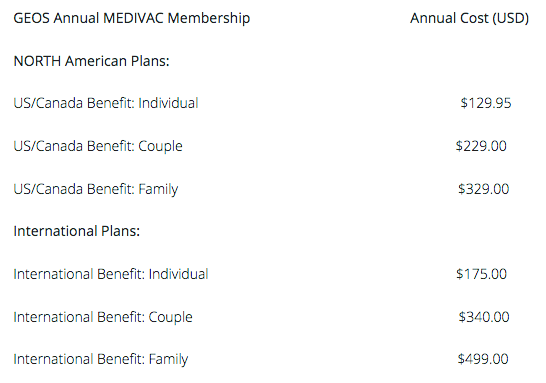
Search & Rescue membership cost

Sharp HealthCare
https://www.sharp.com/services/global-patient-services/
1-888-265-1513
It turns out that finding a facility to accept a medical evacuation is not all that easy. Sharp HealthCare handles this. They run four acute care hospitals in San Diego. They created a Global Patient Services (GPS) program to handle incoming international emergencies.
Most patients are admitted through the ER. They are equipped to accept patients, get them stabilized and get them transferred to your own hospital, or if your insurance company approves, you can stay there and recover.
Their GPS program in San Diego consists of a bilingual team who has close working relationships with medical professionals in Mexico. They can coordinate your transfers and evacuations.
This is not a membership program but a hospital company with a unique service, and anyone can use them. Eventually, they should be paid by your insurance company.
If Binational or your insurance provider has not already contacted GPS on your behalf, you or your family can contact them directly.
Evac insurance choices
Here are a few options for accident and evacuation insurance above and beyond your required in-country health insurance.
Divers Alert Network (DAN)
Dive and non-dive accident plus travel insurance
http://diversalertnetwork.org
When I started scuba diving I found out about Diver’s Alert Network. I use their premium (Guardian) plan, which also covers overland accidents with medical transportation coverage, evacuation, with search and rescue for divers only. DAN costs me $125 annually (plus a $35 membership fee), which is less expensive than other accident and evacuation plans that I can find. They also provide one-time or multi-trip insurance.
This may be your best option for frequent or long-term Baja travel, with the addition of search and rescue for non-dive accidents.
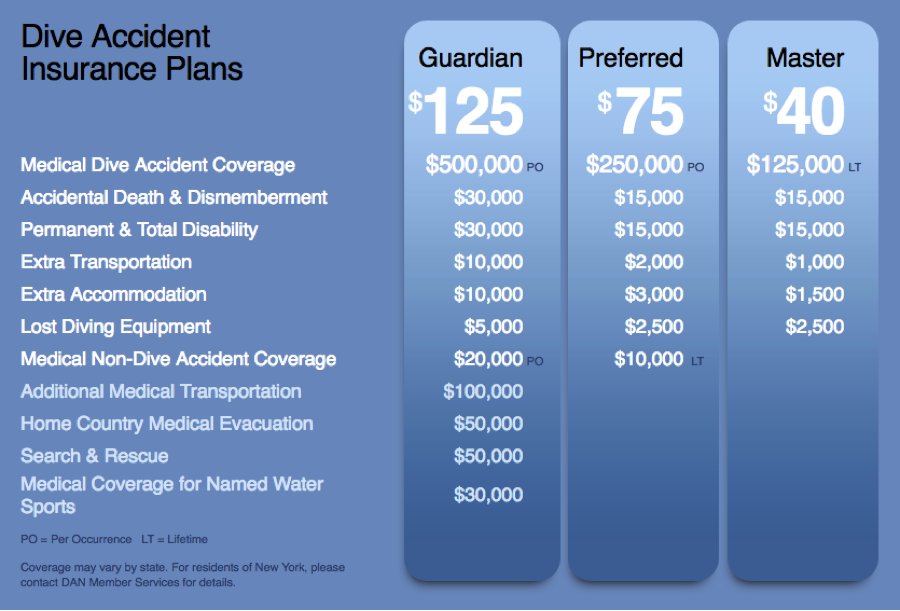
Pricing shown is for their annual plan. DAN’s short-term dive insurance does not include the non-dive accident coverage and medical transportation costs. They put a cap on the cost to get you home at $100,000. The search and rescue benefit is for diving accidents only, so you’ll still need Binational and GEOS Alliance to cover that.
But I love that they have an annual plan so I don’t have to even think about my insurance plan and what country it covers.
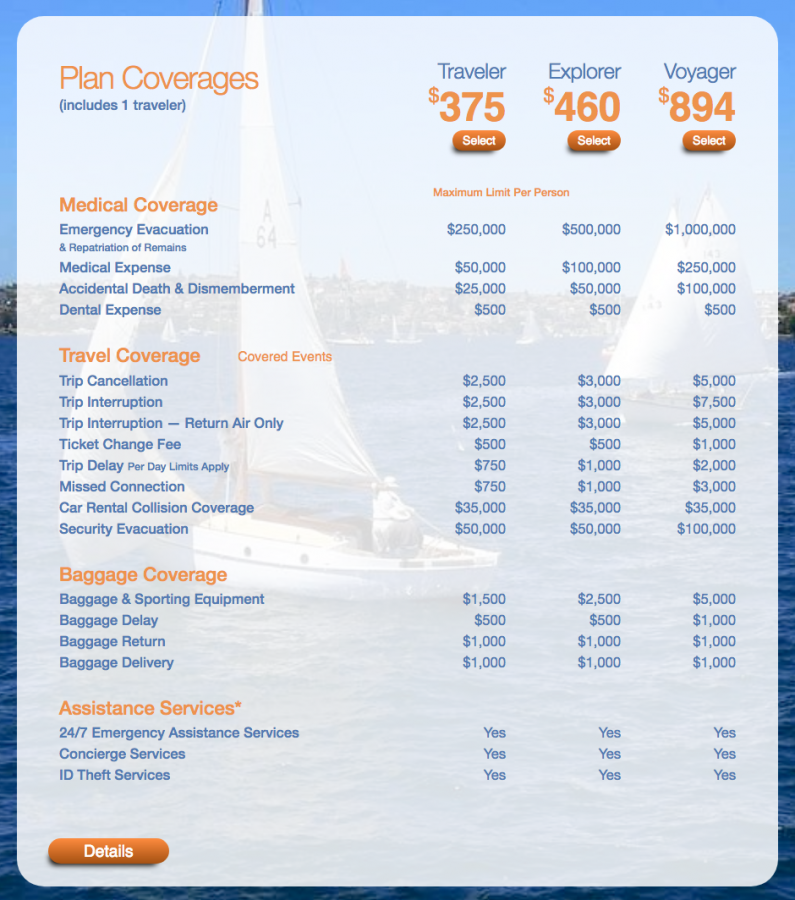
Travel Guard
Travel and medical evacuation insurance
https://www.travelguard.com
https://www.costcotravel.com/Info/Travel-Guard
My friend Pete, founder of Mosko Moto , whose story I shared at the beginning of this post, uses Travel Guard. When I emailed him for an update he said he and Ashly still use the Garmin inReach, too. Here’s his response.
We just used [our inReach] last week to arrange a bailout for a guy we ran into way off the beaten track in the eastern Oregon desert who had high-centered his Excursion while scouting hunting spots. He was able to exchange SMS messages with his wife and a friend, and organize a vehicle to bail him out.
They’re also great for meeting up with friends who might be joining a ride part-way through the trip. To communicate a campsite location to meet at, for example.
Also, for what it’s worth, Travel Guard, the travel insurance company that helped me in my situation in Honduras, just worked with a buddy of mine when he broke his foot in Africa on a motorcycle trip. He was very stoked, saved a ton of cash.
In my research, Travel Guard has similar costs and coverage as World Nomads, which another of my frequently-traveling adventure friend loves.
World Nomads
 Travel and medical evacuation insurance
Travel and medical evacuation insurance
http://worldnomads.com
My friend Jason Moore (host of the Zero to Travel podcast), penned a detailed article about travel insurance that is interesting reading. He’s a longtime world traveler so he should know. He uses World Nomads, which was started by a traveler from Australia, so it has a lot of credibility with budget and adventure travelers and it’s recommended by Lonely Planet. You can get a quote for it at the end of this article but, if you’re over 70, don’t bother. They won’t cover you.
It’s a tough choice for me between DAN, Travel Guard, and World Nomads as the best options for traveling long-term, living, or vacationing in Baja (or anywhere).
My cost for a four-week trip would be $110 for their standard coverage (for activities like motorcycling and scuba diving) and $161 for their Explorer insurance in case you want to do something silly like shark cage diving. For a two-week trip, the cost would be $74 and $102. To cover myself for the entire winter season in Baja (Oct 1-May31) my cost would be $564 and $812. So for me, the DAN service, at $125 annually, makes the most sense. But I think if you’re going for a couple weeks, flying in, renting a car or riding bikes across the border, World Nomads is your best bet.
World Nomads includes evacuation insurance but I’d still tack on the Binational service since they’re in-country experts and I just do not trust a person on an 800 number to be able to coordinate my transport from a remote Baja village to a medical facility for evac. Besides, Binational is a great nonprofit that helps a lot of people so I want to support them.
Here’s WorldNomads’ coverage of accident and evac, trip cancellation, interruption, delay, plus baggage and personal effects.
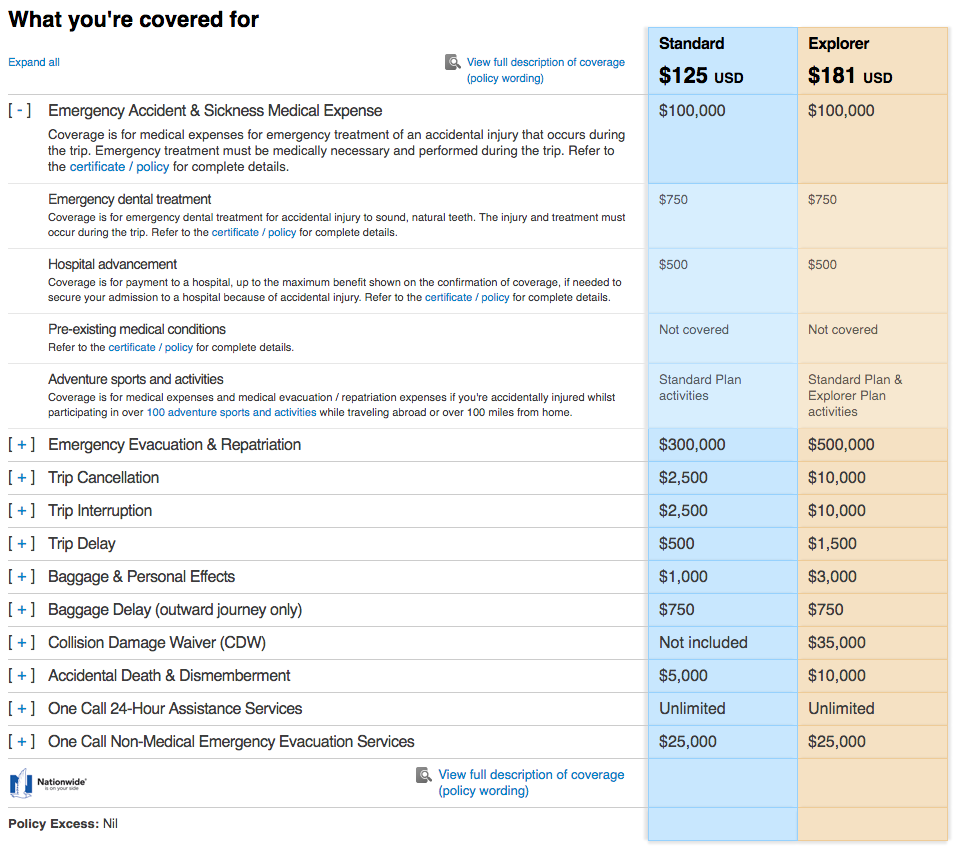
Recommendations
It depends. I hate to say it, but there are so many different travel and preference scenarios that I think you should research carefully and make your own choice.
Don’t forget add-ons like the perks that may be offered by your credit card company, your renters or homeowners insurance (for gear like laptops, smartphones, cameras, and luggage), and the $45/annual Binational membership.
Motorcycle (and vehicle) insurance
If you’re reading this you probably already have Discover Baja vehicle insurance for your car, 4×4, RV, motorhome, motorcycle, or boat. If you don’t, you can find out about it, here. And don’t forget, you need a passport, a passport card, and a tourist permit, too! Don’t forget to get that permit stamped right at the border when you enter and exit.
What does all this cost?
What do you really need? I’m an adventure motorcyclist and scuba diver who spends months at a time in Baja. As you see, there are a lot of good options. Note that in this summary I don’t include baggage or equipment loss as my renters insurance in the US covers that—and I have used it! And I don’t need trip cancellation insurance since I’m riding, not flying to San Diego or Baja. Also note that you may prefer World Nomad over DAN if you’re not a diver and are taking a short vacation. The cost is about the same.
$ 460 InReach Explorer “wearable”
$ 100 SPOT Trace
$ 15 for a 30-day Garmin inReach “Recreation” service plan
$ 135 Divers Alert Network (DAN)
$ 45 Binational Emergency service (annual)
——–
$ 755
That’s $560 for gear and $195 for insurance, not including my renters insurance, which takes care of my laptop and camera gear, plus $560 on gear I just bought. And I didn’t add vehicle insurance, which varies.
That’s it! I hope this post helps you to prepare, ride your own ride, and have a fun and safe journey!
Take this info with you
- Driver’s license
- Health insurance card
- Motorcycle insurance card
- Blood type card
- AMA card
- Current medication list
- Allergy list
Emergency contact list:
- Name and address
- Emergency contacts, with phone and email
- Doctor’s name and phone number
- Lawyer’s name and phone number
- Medical conditions, including past surgeries
Further reading
Destination Wellness – Medical Tourism in Los Cabos
Los Cabos Guide with Featured Medical listings, including American Medical Walk-in Clinic and AMC Hospital.
Got a recommendation? A story to tell?
Have you used any of these services? Have I missed a great service? Do you have a rescue scenario you’d like to share? Did you use the information in this post to purchase insurance and gear? What did you choose and why? Let’s chat in the comments below. Thanks!
—
Carla King has been writing about her motorcycle adventure travels since 1995. Get free stories about her misadventures in North America, China, Europe, India, and Africa, and her current adventures in Baja at CarlaKing.com.


What a fantastic artcle! Thank you!
You’re very welcome! It was enlightening to research :-)
Best,
Carla
Excellent information. Going to re-think some of my current coverages and devices.